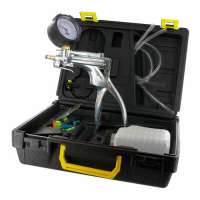SYKES PICKAVANT MANUAL BRAKE BLEEDER
The manual brake bleeder is an essential tool for any mechanic or automotive enthusiast who wants to keep their vehicle's brake system in top condition.
This device has a non-return valve that ensures that air does not re-enter the system, which is crucial to maintain braking effectiveness and avoid the presence of air bubbles in the brake fluid.
With a capacity of 50 cl, it is suitable for most vehicles, allowing the purging process to be carried out efficiently and without complications.
Its ergonomic design makes it easy to handle, and the integrated check valve ensures continuous, uninterrupted flow, providing precise control during operation.
Recommendations for use:
Make sure the vehicle is on a flat surface before beginning the bleed.
Check the brake fluid level before using the bleeder to prevent air from entering the system.
Wear gloves and eye protection to avoid direct contact with brake fluid, which is corrosive.
Properly connect the bleeder hose to the brake bleed valve to prevent fluid leaks.
Bleed the wheels in the correct order (usually furthest to closest to the master cylinder) to ensure complete removal of air in the system.
Maintenance recommendations:
Clean the manual bleeder with distilled water after each use to prevent the buildup of brake fluid residue, which can damage internal components.
Regularly inspect the check valve to ensure it is working properly and replace it if necessary.
Store the bleeder in a dry, clean place, away from corrosive chemicals, to prolong its life and keep it in perfect condition for next use.
This device has a non-return valve that ensures that air does not re-enter the system, which is crucial to maintain braking effectiveness and avoid the presence of air bubbles in the brake fluid.
With a capacity of 50 cl, it is suitable for most vehicles, allowing the purging process to be carried out efficiently and without complications.
Its ergonomic design makes it easy to handle, and the integrated check valve ensures continuous, uninterrupted flow, providing precise control during operation.
Recommendations for use:
Make sure the vehicle is on a flat surface before beginning the bleed.
Check the brake fluid level before using the bleeder to prevent air from entering the system.
Wear gloves and eye protection to avoid direct contact with brake fluid, which is corrosive.
Properly connect the bleeder hose to the brake bleed valve to prevent fluid leaks.
Bleed the wheels in the correct order (usually furthest to closest to the master cylinder) to ensure complete removal of air in the system.
Maintenance recommendations:
Clean the manual bleeder with distilled water after each use to prevent the buildup of brake fluid residue, which can damage internal components.
Regularly inspect the check valve to ensure it is working properly and replace it if necessary.
Store the bleeder in a dry, clean place, away from corrosive chemicals, to prolong its life and keep it in perfect condition for next use.
Bullet points
- Precise Control: The non-return valve ensures that air does not return to the system, allowing for effective and error-free purging.
- Easy to use: Its manual and ergonomic design makes the purging process easy, even for those who do not have much experience in vehicle maintenance.
- Saving time and money: Allows you to bleed the brakes quickly and efficiently, avoiding the need to take the vehicle to the workshop.
- Greater safety: Ensures that the brake system is free of air, which improves braking response and increases driving safety.
SYKES PICKAVANT MANUAL BRAKE BLEEDER reference list
| Ref. | Weight | Price | Material | Sparepart | Accessories | Buy |
|---|---|---|---|---|---|---|
| 660500 | 0.1Kg | 32,10 € | Plastico |  |






























































































































































































